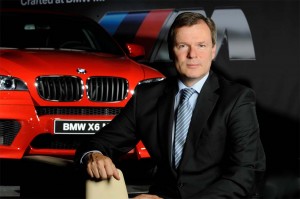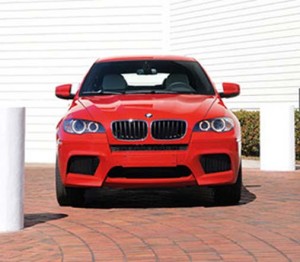Forget raw horsepower numbers, don’t worry about 0 to 60 times. To Kay Segler, it’s all about what “your butt-o-meter…tells you.”
For performance aficionados, few cars command more respect than one with the vaunted BMW “M” badge bolted onto the back. This brand-within-a-brand is, perhaps more than anything else, the reason the Bavarian maker has been able to defend its long-standing claim to being “the ultimate driving machine.”
Yet, at a time when even the most mainstream manufacturers are emphasizing performance, and mid-market entries like the 2011 Ford Mustang are nudging past the once-unimaginable 400 horsepower barrier, M chief Segler says it’s time to rethink what his division stands for. And the new definition doesn’t necessarily require BMW to deliver either the fastest, or the most powerful cars possible.
“The measurement of 0 to 100 (kmh) isn’t as much a thrill anymore,” Segler proclaims during a long dinner in downturn Munich, not far from BMW’s headquarters. What matters more than raw numbers is how a car feels, he explains. “You can measure a lot of things by the numbers, but your butt-o-meter is what tells you” whether you’re satisfied, Segler contends, as he sips a glass of sparkling water, reminding us of Germany’s tough drunk driving laws.
For anyone who thinks of German executives as rigid and unyielding, a conversation with Segler delivers a variety of surprises. Since taking on the helm of what is arguably the halo operation within an already well-respected automaker, early last year, he has shown a surprising willingness to keep an open mind and embrace change.
“The dogmas are gone,” Segler insists, offering up some example to back up that claim.
There was a time when BMW offered only a handful of M models, usually variants of the 3- or 5-Series. It wasn’t all that long ago when company officials would look aghast when asked if there might be the opportunity to work the M magic on one of BMW’s sport-activity vehicles, like the X5. As the recent launch of the X6 M underscores, that taboo is gone.
This was “a big epic battle” that dragged on “for years,” says Segler, conceding the fact that it took a competitor to break down that barrier. The launch of the Porsche Cayenne, notably the Turbo edition, “triggered the appetite” for more performance out of BMW’s X-line.
Another big change for M was the decision to go with a turbocharged drivetrain, something that was also on its “never” list. (Ironically, the decision to go with boosting was made even as arch-rival AMG, the Mercedes-Benz performance arm, abandoned supercharging in favor of a unique, naturally-aspirated V8.)
Going forward, what M decides it needs will be “answered by technology,” no matter what that technology is, contends Segler. But after a pause, he thinks twice about that argument.
There’s a growing push into electrification in the auto industry. No surprise when you’re talking about econocars, like the Toyota Prius hybrid or the eUP battery minicar under development at Volkswagen. But a variety of upscale makers also see an opportunity to use battery power for performance applications. There’s Fisker Automotive, with its planned plug-in hybrid sports car, and the pure battery-electric version of the gull-winged SLS being developed by Mercedes’ AMG.
Segler says he’s willing to “see what it (electric propulsion) can do for us,” but if the skepticism doesn’t immediately show through, he quickly underscores his reservations, asking, “Do you need a high-performance (battery) car to drive 50 kilometers? I doubt it.”
That doesn’t mean Segler’s team can ignore environmental trends, and he promises that the next-generation M5 will produce at least 20% less CO2, “without compromising performance.”
While Segler insists “performance is still a trend,” he is unusually blunt for an automotive executive – German or not – acknowledging that the segment his brand competes in has been shrinking” for several years, down from more than 200,000 vehicle a year to barely 130,000 in 2009.
The question, of course, is why? Is it something driven by the current – and hopefully temporary – global economic downturn, or something more permanent? Either way, Segler is rethinking both what that M represents and who it should appeal to.
“We want to make M young again,” he says, adding a word that isn’t typically associated with the brand, “and affordable. My sons would like to have an M, and when they’re 40, not 60.” His goal, Segler asserts, “is to go towards affordability and freshness.”
Exactly what that means isn’t yet clear. If anything, it’s likely to result in a broadening of the M line, rather than a wholesale move down-market. The next-generation M3 isn’t likely to be a Mustang GT with a pair of kidney grilles and the BMW “spinner” logo. But expect to see not only classic M products but also more M options, like body trim and engine accessories, available for other BMW models.
Segler notes that he’s also quite interested in motor sports, and “We want to have our drivers (show up) on race tracks” for more amateur events.
To entice more owners the maker has set up a performance driving school at its U.S. factory, in Spartanburg, South Carolina.
That factory, one might recall, also broke the rules for parent company BMW, which long insisted only Germans could build its products. So, perhaps the rule is to keep breaking the rules. That’s something Kay Segler quite comfortable living with.
“The dogmas are gone,” says BMW M chief Kay Segler.
By Paul A. Eisenstein
Posted: 3/30/10
Forget raw horsepower numbers, don’t worry about 0 to 60 times. To Kay Segler, it’s all about what “your butt-o-meter…tells you.”
For performance aficionados, few cars command more respect than one with the vaunted BMW “M” badge bolted onto the back. This brand-within-a-brand is, perhaps more than anything else, the reason the Bavarian maker has been able to defend its long-standing claim to being “the ultimate driving machine.”
Yet, at a time when even the most mainstream manufacturers are emphasizing performance, and mid-market entries like the 2011 Ford Mustang are nudging past the once-unimaginable 400 horsepower barrier, M chief Segler says it’s time to rethink what his division stands for. And the new definition doesn’t necessarily require BMW to deliver either the fastest, or the most powerful cars possible.
“The measurement of 0 to 100 (kmh) isn’t as much a thrill anymore,” Segler proclaims during a long dinner in downturn Munich, not far from BMW’s headquarters. What matters more than raw numbers is how a car feels, he explains. “You can measure a lot of things by the numbers, but your butt-o-meter is what tells you” whether you’re satisfied, Segler contends, as he sips a glass of sparkling water, reminding us of Germany’s tough drunk driving laws.
For anyone who thinks of German executives as rigid and unyielding, a conversation with Segler delivers a variety of surprises. Since taking on the helm of what is arguably the halo operation within an already well-respected automaker, early last year, he has shown a surprising willingness to keep an open mind and embrace change.
“The dogmas are gone,” Segler insists, offering up some example to back up that claim.
There was a time when BMW offered only a handful of M models, usually variants of the 3- or 5-Series. It wasn’t all that long ago when company officials would look aghast when asked if there might be the opportunity to work the M magic on one of BMW’s sport-activity vehicles, like the X5. As the recent launch of the X6 M underscores, that taboo is gone.
This was “a big epic battle” that dragged on “for years,” says Segler, conceding the fact that it took a competitor to break down that barrier. The launch of the Porsche Cayenne, notably the Turbo edition, “triggered the appetite” for more performance out of BMW’s X-line.
Another big change for M was the decision to go with a turbocharged drivetrain, something that was also on its “never” list. (Ironically, the decision to go with boosting was made even as arch-rival AMG, the Mercedes-Benz performance arm, abandoned supercharging in favor of a unique, naturally-aspirated V8.)
Going forward, what M decides it needs will be “answered by technology,” no matter what that technology is, contends Segler. But after a pause, he thinks twice about that argument.
There’s a growing push into electrification in the auto industry. No surprise when you’re talking about econocars, like the Toyota Prius hybrid or the eUP battery minicar under development at Volkswagen. But a variety of upscale makers also see an opportunity to use battery power for performance applications. There’s Fisker Automotive, with its planned plug-in hybrid sports car, and the pure battery-electric version of the gull-winged SLS being developed by Mercedes’ AMG.
Segler says he’s willing to “see what it (electric propulsion) can do for us,” but if the skepticism doesn’t immediately show through, he quickly underscores his reservations, asking, “Do you need a high-performance (battery) car to drive 50 kilometers? I doubt it.”
That doesn’t mean Segler’s team can ignore environmental trends, and he promises that the next-generation M5 will produce at least 20% less CO2, “without compromising performance.”
While Segler insists “performance is still a trend,” he is unusually blunt for an automotive executive – German or not – acknowledging that the segment his brand competes in has been shrinking” for several years, down from more than 200,000 vehicle a year to barely 130,000 in 2009.
The question, of course, is why? Is it something driven by the current – and hopefully temporary – global economic downturn, or something more permanent? Either way, Segler is rethinking both what that M represents and who it should appeal to.
“We want to make M young again,” he says, adding a word that isn’t typically associated with the brand, “and affordable. My sons would like to have an M, and when they’re 40, not 60.” His goal, Segler asserts, “is to go towards affordability and freshness.”
Exactly what that means isn’t yet clear. If anything, it’s likely to result in a broadening of the M line, rather than a wholesale move down-market. The next-generation M3 isn’t likely to be a Mustang GT with a pair of kidney grilles and the BMW “spinner” logo. But expect to see not only classic M products but also more M options, like body trim and engine accessories, available for other BMW models.
Segler notes that he’s also quite interested in motor sports, and “We want to have our drivers (show up) on race tracks” for more amateur events.
To entice more owners the maker has set up a performance driving school at its U.S. factory, in Spartanburg, South Carolina.
That factory, one might recall, also broke the rules for parent company BMW, which long insisted only Germans could build its products. So, perhaps the rule is to keep breaking the rules. That’s something Kay Segler quite comfortable living with.


